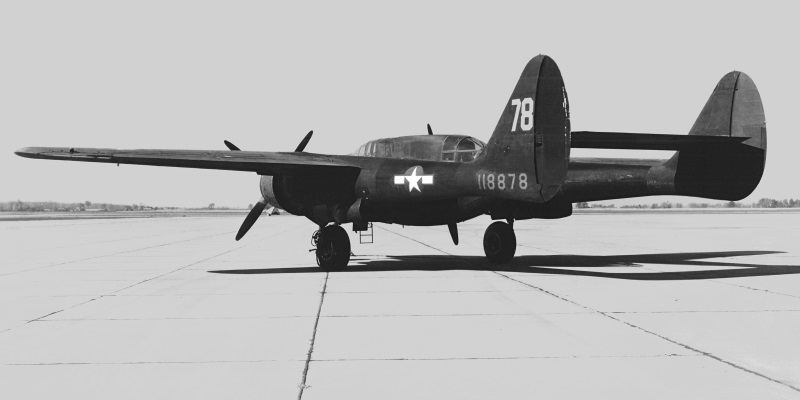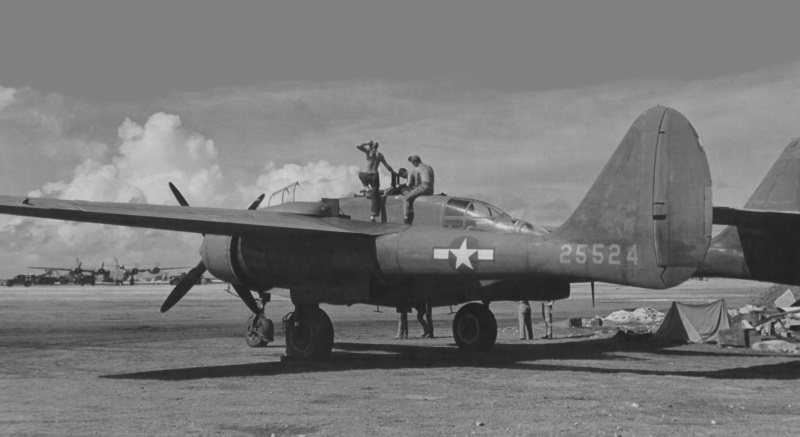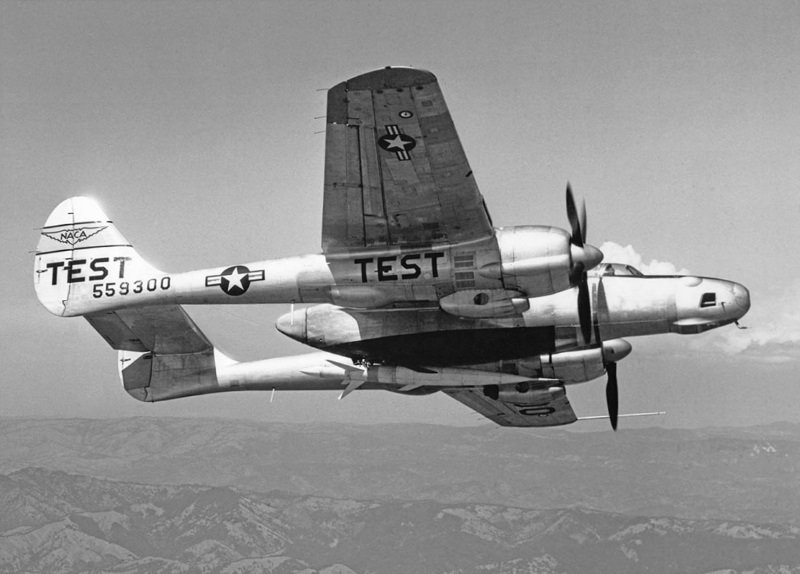
* The development of radar early in World War II led to the concept of a radar-equipped interceptor that could hunt in night and bad weather. The British introduced the concept by fitting Bristol Blenheim light bombers with "airborne intercept (AI)" radar and guns for operation as "night fighters", then went on to operate more formidable Bristol Beaufighter and de Havilland Mosquito night fighter variants.
The US Army Air Forces (USAAF) pressed the Douglas A-20 Havoc bomber into service as a radar-equipped night fighter, designated "P-70", but it left much to be desired. The USAAF then obtained a purpose-built night fighter, the Northrop "P-61 Black Widow" that was much more satisfactory, serving with distinction late in the war. This document provides a history and description of the P-61, as well as its "F-15 Reporter" reconnaissance derivative. A list of illustration credits is included at the end.
* The roots of the Northrop P-61 went back to 1940, before America entered World War II. Officers of the US Army Air Corps (USAAC) had gone to the UK to be briefed on AI and night fighter development, and when they got back home they pressed for the development of a US night fighter, envisioning a twin-engine machine since the AIs of the time were bulky and heavy.
The chief of research of Northrop Aircraft, Vladimir H. Pavlecka, got wind of the lobbying and worked with his boss, Jack Northrop, to come up with a proposal to fill the need. The general concept they passed back to the Air Corps was of a twin-boom night fighter, with a general configuration like that of a Lockheed P-38 Lightning fighter, but much bigger, and powered by twin Pratt & Whitney (P&W) R-2800 Double Wasp air-cooled two-row, 18-cylinder radial engines.
The Air Corps liked the idea, though some alterations were suggested, and a contract was issued for two prototypes of the "XP-61" in January 1941, followed by a contract in March for 13 "YP-61" evaluation machines and a static test airframe. A full-scale mockup was ready by April. By February 1942, 410 P-61s were on order from the US Army Air Forces -- USAAF, which had superseded the Air Corps in June 1941 -- even though the first prototype hadn't flown yet: the US was now at war, and new weapons were needed yesterday.
The first prototype performed its initial flight on 26 May 1942, with test pilot Vance Breese at the controls. It was powered by twin P&W R-2800-10 radials providing 1,490 kW (2,000 HP) each. The aircraft was a hulking and sinister-looking machine, and though the prototypes flew in natural metal, the aircraft was named the "Black Widow".

The 13 YP-61s, all painted olive drab topside and neutral gray underneath, were delivered in August and September 1943, with the initial production "P-61A-1-NO" rolled out of the Northrop plant in Hawthorne, California, in October 1943. (The "NO" stood for "Northrop / Hawthorne", but since all P-61s would be built at that plant, that suffix will not be used further here.) All but early production were painted gloss black, that proving much harder to see at night than olive drab.
BACK_TO_TOP* The P-61A provides a baseline for description of the type. It was of all-metal construction, as mentioned with a twin-boom arrangement like that of the P-38. It had a central fuselage with a crew of pilot, radar operator / front gunner, and rear gunner, with extensive fore and aft glazing. The pilot sat forward of the radar operator / front gunner, who sat in a stepped-up cockpit to the rear of the pilot's cockpit. The rear glazing proved fragile in the prototypes and evaluation machines, with a tendency to blow out from compression in dives. It was beefed up in the P-61A, though the problem would still crop up on occasion. The cockpit glazing was also redesigned for the P-61A, the primary change being a switch from curved windscreens to flat armor-glass windscreens.
Armament included four forward-firing Hispano M2 20-millimeter cannon in a belly tray, plus four Browning M2 12.7-millimeter (0.50-caliber) machine guns in a General Electric-built top turret. The XP-61 prototypes had been unarmed, with a dummy turret, while some of the YP-61s had turrets with only two Brownings fitted. The top turret would prove troublesome in several respects:
P-61As weren't delivered with the top turret. In some cases, a fuel tank was added in the top turret position, and it appears that a pack of four fixed forward-firing Brownings was sometimes fitted in place of the turret.
The gunner still occasionally flew in such aircraft, being used as an additional pair of eyes to keep a lookout from the rear glazing. Incidentally, there was a pressure switch on the nose gear assembly that prevented the guns from going off on the ground; for ground firings, the nosewheel assembly had to be propped up to prevent the switch from being activated. The crew and vital systems were protected from enemy fire by strategically-placed armor plating.
The radar was an "SCR-720", where "SCR" stood for "Signal Corps Radio", being the standard designation for Army radio and radar gear at the time. The XP-61 prototypes didn't have radar, with ballast in its place. Some YP-61s had been initially evaluated with the earlier "SCR-520", America's first AI radar.
The Double Wasp engines drove four-bladed variable-pitch Curtiss electric propellers. There were two fuel tanks in each wing -- one just outboard of the engine boom, one inboard -- with a total capacity of 2,445 liters (646 US gallons). The wings were very broad and featured wide, big flaps. There were spoilers on top of the wing for roll control, though ailerons were also fitted. The twin-boom configuration, incidentally, was at least partly chosen because a night fighter might need to close in close on a target to get a positive identification, and the twin tailfins made the aircraft more controllable in another aircraft's airstream.
The P-61A featured tricycle landing gear, with all gear assemblies featuring single wheels and retracting backwards, the main gear into the engine booms. Despite its large size, the P-61 was surprisingly agile and handled well. Partly thanks to the twin-boom configuration, there were no major problems with flying it with an engine out, which could be a hair-raising experience with some other twin-engine aircraft.

Later blocks of the P-61A added various improvements:
There was some thought of the USAAF adopting the British Mosquito NF.XVII night-fighter instead of the Black Widow -- or the British Royal Air Force adopting the P-61 -- but a comparative evaluation of the two types showed them to be generally equivalent, with each having its own idiosyncratic advantages and disadvantages. The USAAF and RAF stayed with their own choices. Although the RAF evaluated the Black Widow, an order for 50 was canceled.
BACK_TO_TOP* The "P-61B" featured a set of minor improvements over the P-61A:
The only particularly visible external difference between a P-61A and P-61B was that the P-61B featured a prominent access panel behind the nose radome.
___________________________________________________________________
NORTHROP P-61B BLACK WIDOW:
___________________________________________________________________
wingspan:
20.12 meters (66 feet)
wing area:
61.53 sq_meters (662.4 sq_feet)
length:
15.11 meters (49 feet 7 inches)
height:
4.47 meters (14 feet 8 inches)
empty weight:
10,637 kilograms (23,450 pounds)
MTO weight:
16,420 kilograms (36,200 pounds)
max speed at altitude:
590 KPH (365 MPH / 320 KT)
service ceiling:
10,090 meters (33,100 feet)
range:
2,175 kilometers (1,350 MI / 1,175 NMI)
___________________________________________________________________
The initial production block "P-61B-1" and "P-61B-2" were followed by improved blocks:
Three P-61 squadrons were operating in the Pacific theater by mid-1944. The first kill was scored on 30 June, when a P-61 of the 6th Night Fighter squadron shot down a Mitsubishi G4M bomber. At the time the Japanese, unable to face up to American air superiority in daylight, were performing nuisance night raids on American installations. Once the Black Widow went into service, the raiders increasingly failed to come back home.
Black Widows flew missions all over the Pacific, from New Guinea to the Philippines and from China. With their heavy armament, if they could find the target, they could usually kill it very quickly. As Japanese night raids began to fade out, the Black Widows were increasingly used in the ground-attack role. They used cannon as well as napalm bombs and rockets for the attacks.
Late in the war, a B-61 was forced to shoot down a "friendly" Boeing B-29 Superfortress returning to base on Iwo Jima after a raid on Osaka. The B-29 had been hit by flak, killing the pilot, badly injuring the copilot, and ensuring that the aircraft could not drop its bombs. There was no way it could be safely landed, so the crew bailed out over Iwo Jima, and the P-61 then engaged it to make sure it went into the drink. The Superfortress proved amazingly durable as the Black Widow chewed it up, but the bomber finally went into the sea.

* P-61s were in combat in Europe by the summer of 1944, initially fighting German V-1 cruise missile ("buzz bomb") attacks on England, with the first P-61 kill of a V-1 on 16 July 1944. P-61s destroyed at least nine V-1s, a small part of the total destroyed. One P-61 pilot destroyed a V-1 at close range, to have it blow up in his face; the aircraft came back down with burn damage.
As Allied forces penetrated deeper into Europe, the Black Widows moved to France. With the Luftwaffe running out of fuel, the P-61s didn't have too much opportunity to score aerial kills, but they kept busy in the night ground-attack role. They were good at busting trains at night, and performed heavy combat during the Battle of the Bulge late in 1944. Three Black Widow crews became aces:
There were no real foreign users of the P-61. The Chinese Communists captured a few from the USAAF after the war, but it appears they saw little or no flight service. A handful of US Marine aircrew flew in USAAF Black Widows in Europe to get experience in night-fighter operations. The US Navy had planned to obtain the P-61 for use by the Marines off of land bases, but decided instead to obtain the carrier-capable Grumman F7F Tigercat as a night-fighter. Immediately after the end of the war, the Marines did obtain a dozen hand-me-down P-61Bs for use as radar trainers for Tigercat aircrew, under the designation of "F2T-1N". They were withdrawn from service in 1947.
BACK_TO_TOP* Although aircrews who had flown the P-61A and P-61B were generally enthusiastic about the Black Widow, there were complaints that it needed better performance. In November 1943, the USAAF told Northrop to go ahead with the "P-61C", featuring turbocharged R-2800-73 radials providing a maximum power of 2,090 kW (2,800 HP). Northrop engineers had originally considered turbocharged engines, but worried they would cut into range and endurance. However, the need for speed outweighed that concern.
Since Northrop was focused on the XB-35 flying-wing bomber at the time, work on the P-61C was conducted at low priority, and in fact much of the P-61C effort was farmed out to Goodyear of Akron, Ohio, which had previously supplied subassemblies for Black Widow production. The first production "P-61C-1" wasn't rolled out until early 1945. It could be distinguished from earlier P-61 variants by the prominent bulges for the turbochargers under the engine nacelles. It also featured big A.O. Smith four-bladed paddle propellers to handle the extra power. The P-61C was built with perforated airbrakes above and below the wings to prevent a pilot from overshooting a target during a fast intercept -- but during a test of the airbrakes, they tore the wings off the aircraft, the pilot managing to bail out safely, and so they were rendered nonfunctional in all service aircraft.
Performance clearly improved, the machine being capable of 690 KPH (430 MPH) at altitude, even though the empty weight of the aircraft had increased by about 900 kilograms (2,000 pounds). Ceiling was raised to 12,500 meters (41,000 feet), and climb rate was substantially faster as well. However, the greater weight made the P-61C also less agile, heavier on the controls, and reluctant to get off the runway.
The P-61C went into service with the USAAF in July 1945, but the war ended before the variant could see combat. 41 were built in early 1946; more had been on order, but the end of the war led to the cancellation of the orders.
* There was actually some waffling over the engine configuration of the P-61C due to demands on P&W production, with two prototypes built featuring alternative R-2800-77 engines under the designation of "XP-61D". Initial flight of the first was in November 1944. The decision was made to go with the P-61C configuration, and both XP-61Ds ended up being scrapped.
BACK_TO_TOP* Work was also performed on a day fighter version of the Black Widow, with two P-61Bs converted to the "XP-61E" configuration. The major change was the complete redesign of the central fuselage to a more streamlined form with a tandem-seat bubble canopy, the third crew position being eliminated and increased fuel tankage included in its place. A ladder was fitted to the left side of the fuselage to allow the crew to get in and out. The four 20-millimeter cannon were retained, but the radar and turret were deleted, four fixed 12.7-millimeter Brownings being fitted in the nose, with 300 rounds per gun.
The need for a new long-range escort fighter fell off after the program was initiated, and so XP-61E development was conducted on a low-priority basis, the first prototype not being completed until March 1945. The first prototype had a canopy that hinged open to the left, and its Brownings were fitted in a 2x2 arrangement; the second had a canopy that slid backward to open, and the Browning were arranged in a horizontal line. The second XP-61E was lost in a take-off accident in April 1945, the pilot walking away unharmed but the aircraft a total loss.
* Performance of the XP-61Es was good, but the new North American P-82 Twin Mustang was much more impressive, and so the XP-61E effort was abandoned. However, the work did not go to waste. In the summer of 1945, the surviving XP-61E was modified to an unarmed photo-reconnaissance configuration, with the guns yanked, the airbrakes on the wings removed, and a camera nose installed. Six cameras could be fitted in a range of possible configurations; the camera nose added 23 centimeters (9 inches) to the length of the aircraft. Initial flight of the "XF-15" -- the "F" meaning "foto" in those days -- was on 3 July 1945. A second XF-15 was modified from a P-61C, with the same general arrangement but the turbocharged engines.
The USAAF was enthusiastic enough to order the type into production with the turbocharged engines as the "F-15A Reporter" in June, even before the first flight of the XF-15. With the end of the war, most of the order was canceled, with only 36 delivered. All were "F-15A-1" machines except the last, which was an "F-15A-5", featuring a modified camera nose. The F-15As retained the two-seat configuration of the XP-61E, with the back-seater operating the cameras. The back-seater also had a set of simple flight controls to allow him to spell the pilot.

Most operated out of Japan, performing an administrative photo-survey of the country under the "Post-Hostilities Mapping Program" -- which also mapped the Korean peninsula, providing information that would come in handy in 1950, when the Korean War broke out. F-15As also mapped the route of the Bataan Death March in the Philippines to support war crimes trials. In 1948, when the modern USAF designation scheme was introduced, the F-15As were redesignated "RF-61C". The last were removed from service in the spring of 1949, with most of them scrapped.
* The P-61 remained in service for a few years after the war, being replaced by the F-82F Twin Mustang, which itself was quickly replaced by the Northrop F-89 Scorpion. Some Black Widows were used for trials, including engine tests, test launches of various missiles and drones, as well as test drops of aircraft aerodynamic models, and ejection-seat trials. The ejection-seat test machine, incidentally, was named JACK-IN-THE-BOX.

In 1946 and 1947, a number of P-61s and F-15s were employed in the US Weather Service's Project THUNDERSTORM, intended to research violent weather, with armament removed and the aircraft fitted with instrumentation. They were given some flashy markings for the occasion. They flew, of course, into thunderstorms, often being struck by lightning, and sometimes suffering damage from hail. No doubt the flights could be exciting -- not necessarily in a good sort of way -- but no aircraft were lost, and the exercise provided valuable data.
A few F-15As were sold off to civilian operators, to be used as photo-mapping machines into the 1950s, and at least one flew in the civil fire-fighting role. One P-61C was flown by Northrop as a chase plane. No Black Widows remain in flight status, though a few still survive as static displays.
BACK_TO_TOP* Sources include:
* Illustrations credits:
* Revision history:
v1.0.0 / 01 apr 17 v1.0.1 / 01 mar 19 / Review & polish. v1.1.0 / 01 feb 21 / Review & polish. v1.1.1 / 01 feb 22 / Review & polish. v1.1.2 / 01 jan 24 / Review & polish. (+)BACK_TO_TOP
